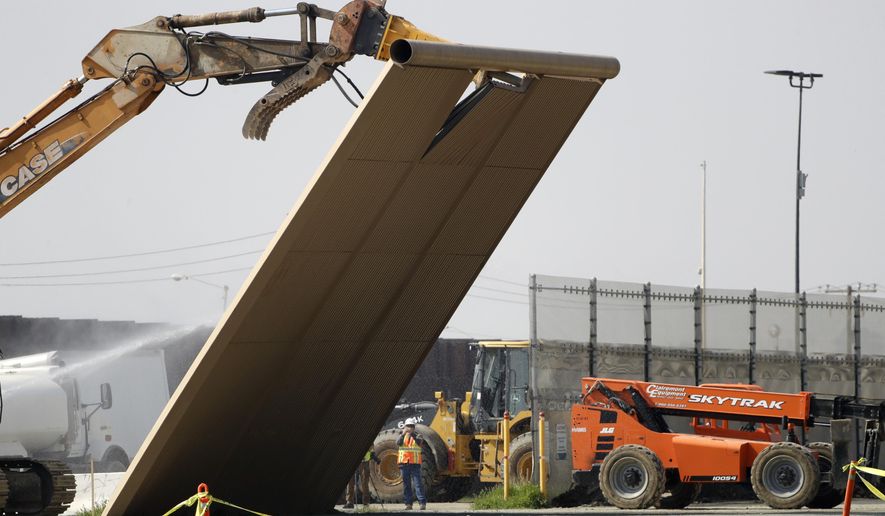The prototypes built as part of President Trump’s border wall competition were torn down Wednesday after officials said they had served their purpose and were standing in the way of building a new section of actual border fencing.
Photos and video from San Diego showed a hydraulic jackhammer being used to punch into the prototypes, knocking them to the ground while a water cannon sprayed the area. One design remained standing Wednesday afternoon. Local press reported that it was too sturdy to be knocked down with the jackhammer.
The demolition was a quick end to a high-profile symbol of Mr. Trump’s campaign promise, though an official at U.S. Customs and Border Protection said they had already gleaned what they could from the prototypes.
“We learned a lot from them, but we don’t necessarily have a purpose or use for them,” the official said.
What they learned was that the existing designs were good enough.
Trump opponents took to Twitter to cheer the prototypes’ demise and saw metaphors in photos depicting the razings.
Mr. Trump had touted the prototypes as a major part of his campaign promise to build a border wall. He at one point suggested that he would be personally involved in picking a winning design and traveled to the border in San Diego to see the prototypes up close.
CBP said in 2017 that it had allocated $20 million for the prototypes and selected six companies to build the eight designs.
But agents said none of them turned out to be practical, and a government audit concluded that none of them could be built without needing significant modifications.
Congress has been cool to the prototypes, including language in spending bills preventing the Trump administration from constructing any design that didn’t exist under President Obama.
Agents said that was no big deal because the bollard-style fence was good.
But it has been a black eye for Mr. Trump, who has repeatedly talked about the intricacies of fence design — often in contradictory terms.
He bragged this week that the wall he will be building is more attractive than what had been built in the past.
“We have a much better prototype. It’s actually a beautiful wall,” he said. “You know, I’ve always said part of the wall was that previous administrations, when they did little walls, they built them so badly. So badly. It’s so unattractive. I wouldn’t want them in my backyard. And the new one is incredible looking. It’s a piece of art, in a sense. And it’s, by the way, more effective.”
Asked what the president meant, the CBP official Wednesday said she couldn’t speak for Mr. Trump.
When the government asked for bids to build the prototypes, the walls were supposed to be able to withstand breaching attempts for up to four hours and to be difficult to climb. They were also supposed to look imposing.
Of the eight prototypes, six of them had solid construction at ground level, which meant agents didn’t have visibility into Mexico. Agents said that was a major flaw because it meant they couldn’t see people preparing for an attempt to jump the border, and it also gave bad actors a better chance at ambushing Border Patrol agents.
Two models did have slats at the base, with solid construction at the top.
Some had protruding structures at the top that were supposed to deter climbers.
The CBP official said they did learn lessons from the prototypes, such as additional methods for internally hardening bollards used in fencing.
Part of the reason the walls need to come down is that they are in the way of real fence construction. The administration is about to begin building a secondary fence in part of San Diego, and the path will run through where the prototypes were built.
In addition to those eight prototypes, another set was built on a separate Border Patrol site. Those were used for breach-testing. The CBP official said those already have been taken down.
• Stephen Dinan can be reached at sdinan@washingtontimes.com.




Please read our comment policy before commenting.